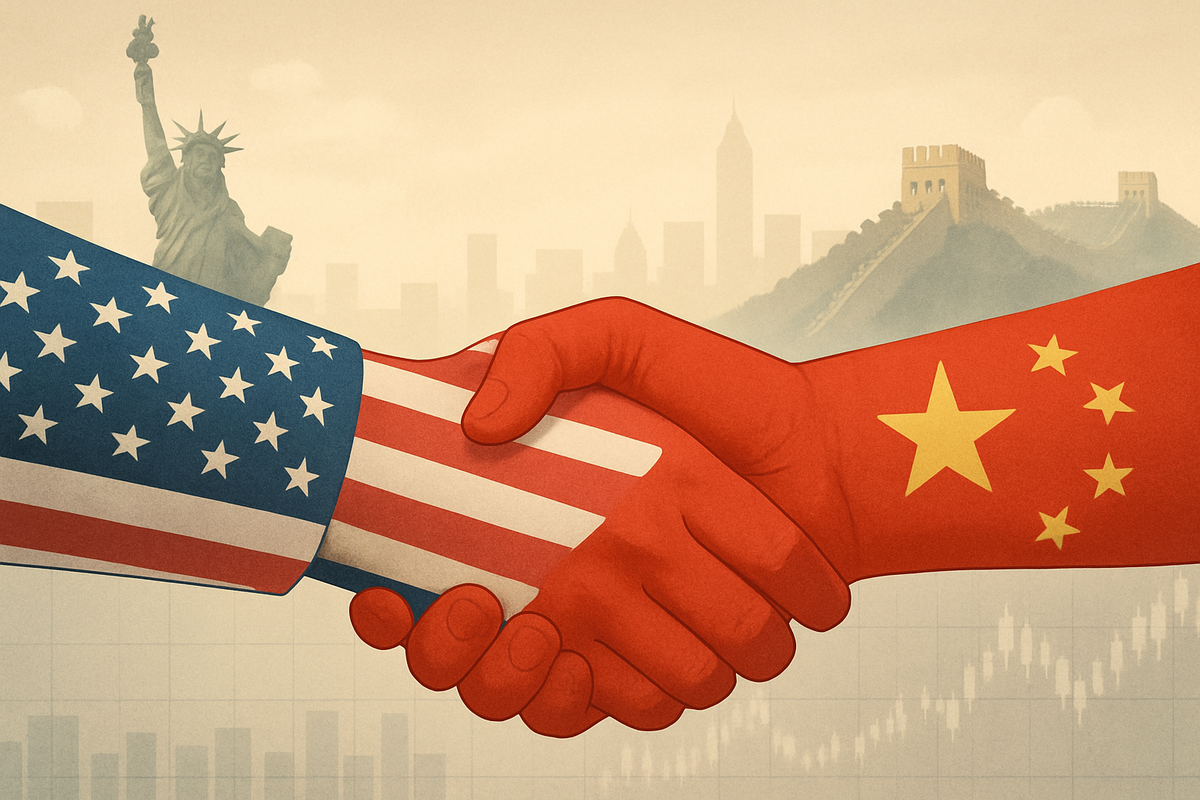
The White House has announced a 90-day extension of its trade truce with China, a move that has temporarily defused escalating tensions and delayed the imposition of hefty tariffs. This widely anticipated decision has been met with a sigh of relief across global financial markets, easing widespread concerns about a potential full-blown trade war between the world's two largest economies.
This extension provides a crucial window for continued negotiations, aiming to address deep-seated trade imbalances and contentious issues that have plagued U.S.-China relations for years. While the immediate market reaction has been positive, the underlying challenges remain, and the coming months will be critical in determining the long-term trajectory of this pivotal economic relationship.
Trade Tensions Eased: A 90-Day Reprieve
On Monday, August 11, 2025, President Donald Trump signed an executive order extending the pause on increased tariffs for another 90 days, pushing the deadline to November 10, 2025. This marks the second such extension of the trade truce, a testament to the complexity and sensitivity of the ongoing negotiations. Beijing reciprocated, also extending its suspension of additional tariffs on U.S. goods. Had this extension not occurred, tariffs on Chinese imports into the U.S. could have surged to an alarming 145%, with China's retaliatory tariffs on American goods potentially reaching 125%, effectively creating a "virtual trade embargo."
The primary impetus behind this extension is to provide more time for productive discussions between Washington and Beijing. The negotiations aim to tackle a broad spectrum of unresolved trade issues, including significant trade imbalances, allegations of unfair trade practices, and the expansion of market access for American exports. Broader concerns related to national security and economic matters, such as fentanyl flows, rare-earth controls, and tech export curbs (particularly on advanced AI chips), are also on the table. The White House indicated that China has been taking "significant steps" toward addressing American concerns, which contributed to the decision. This reprieve also offers a sense of certainty for businesses, especially as the critical year-end holiday shopping season approaches, preventing a sudden surge in import costs that could have severely impacted retailers and consumers. Furthermore, the extension could pave the way for a meeting between President Trump and Chinese President Xi Jinping in late October, potentially on the sidelines of an international meeting in South Korea, to finalize a comprehensive trade agreement.
The announcement of the 90-day trade truce extension triggered a positive reaction across global financial markets, largely easing widespread concerns about a potential escalation of the trade war. While the reaction was positive, it was not entirely unexpected, as markets had largely anticipated the extension. Stock markets globally saw gains: bourses in Australia and Japan hit record highs, with Tokyo's Nikkei share index rising 2.5% and the Australian ASX 200 index closing up 0.41%. In China, the Shanghai composite index rose by 0.5%, while European stock markets also opened higher. U.S. markets experienced gains, with the S&P 500 rising 0.9%, the Dow up 1%, and the tech-focused Nasdaq climbing 1.1%. Oil prices also saw an uptick, with Brent crude futures increasing by 0.4% to $66.90 a barrel and U.S. West Texas Intermediate crude futures rising by 0.4% to $64.20. This extension is widely viewed as averting an immediate and dangerous showdown, providing a crucial "temporary reprieve" and lowering anxiety on both sides.
Navigating the Truce: Winners and Losers in the Global Market
The extension of the U.S.-China trade truce offers a temporary reprieve for many, but its impact is not uniformly positive across all sectors and companies. While the immediate avoidance of higher tariffs is a win for many, the prolonged uncertainty still creates a challenging environment for long-term strategic planning.
Companies heavily reliant on global supply chains, particularly those with significant manufacturing operations or sourcing from China, are among the primary beneficiaries of this extension. For instance, technology giants like Apple Inc. (NASDAQ: AAPL) and HP Inc. (NYSE: HPQ), which assemble a substantial portion of their products in China, can breathe a sigh of relief as the threat of increased import costs on their finished goods is temporarily averted. Similarly, major retailers such as Walmart Inc. (NYSE: WMT) and Target Corporation (NYSE: TGT), which import a vast array of consumer goods from China, will avoid immediate price hikes that could dampen consumer spending, especially heading into the crucial holiday season. The automotive sector, with its intricate global supply chains, also benefits. Companies like General Motors Company (NYSE: GM) and Ford Motor Company (NYSE: F), which have significant sales and manufacturing presences in both the U.S. and China, gain valuable time to adjust their strategies without the immediate pressure of punitive tariffs.
Conversely, some sectors and companies might find themselves in a more precarious position, or at least facing continued uncertainty. U.S. agricultural exporters, such as those dealing in soybeans and pork, have been hit hard by China's retaliatory tariffs. While the extension prevents further escalation, the existing tariffs remain in place, continuing to impact their profitability and market access. Companies like Archer-Daniels-Midland Company (NYSE: ADM) and Tyson Foods, Inc. (NYSE: TSN) will continue to navigate these challenges. Furthermore, companies that have already begun to diversify their supply chains away from China, investing heavily in new manufacturing facilities in other countries, might see a slower return on those investments if the trade truce holds and the urgency to relocate diminishes. This could affect companies that have made significant capital expenditures in anticipation of a prolonged trade war.
The extension also creates a mixed bag for companies involved in the semiconductor industry. While the broader market stability is beneficial, the underlying tensions regarding technology transfer and intellectual property remain. Companies like Qualcomm Incorporated (NASDAQ: QCOM) and Intel Corporation (NASDAQ: INTC), which have significant business ties with Chinese technology firms, will continue to operate under the shadow of potential restrictions and export controls, particularly concerning advanced AI chips. The ongoing negotiations around these sensitive technologies mean that even with a truce, the long-term outlook for these companies in the Chinese market remains uncertain.
Broader Implications: A Fragile Equilibrium in Global Trade
The extension of the U.S.-China trade truce, while a welcome pause, underscores the fragile equilibrium in global trade and highlights the deep-seated structural issues that continue to challenge the international economic order. This event fits into a broader trend of increasing economic nationalism and protectionist sentiments observed globally, where major powers are re-evaluating their trade relationships and prioritizing domestic interests.
The potential ripple effects on competitors and partners are significant. For countries that have benefited from trade diversion due to the U.S.-China trade war, such as Vietnam, Mexico, and Taiwan, a prolonged truce or eventual resolution could mean a reduction in new business opportunities. Conversely, a renewed escalation would further accelerate the trend of supply chain diversification, potentially benefiting these alternative manufacturing hubs. The regulatory and policy implications are also profound. The ongoing negotiations are not just about tariffs; they delve into fundamental issues like intellectual property rights, forced technology transfer, state subsidies, and market access. The outcome of these discussions could set new precedents for international trade agreements and influence how countries approach bilateral and multilateral trade relations in the future.
Historically, trade disputes between major economic powers have often been protracted and complex, with resolutions taking years to materialize. The current situation bears some resemblance to past trade frictions, such as the U.S.-Japan trade disputes in the 1980s, which also involved accusations of unfair trade practices and market access issues. However, the scale and interconnectedness of the U.S. and Chinese economies today make the current dispute far more impactful on global supply chains and financial markets. The emphasis on national security concerns, particularly regarding technology, adds another layer of complexity that was less prominent in previous trade conflicts. This truce, therefore, is not merely a delay but a critical period for both nations to recalibrate their strategies and potentially redefine the terms of their economic engagement.
The broader significance extends to the World Trade Organization (WTO) and the multilateral trading system. The U.S.-China trade war has highlighted the limitations of the current WTO framework in addressing complex issues like state-owned enterprises and digital trade. The outcome of these bilateral negotiations could either reinforce the need for WTO reform or further push nations towards bilateral agreements, potentially weakening the multilateral system. The truce, therefore, is a moment for reflection on the future of global trade governance and the role of international institutions in mediating economic disputes.
What Comes Next: Navigating the Path Ahead
The 90-day extension of the U.S.-China trade truce sets the stage for a critical period of intense negotiations and strategic maneuvering. In the short term, the immediate focus will be on the ongoing discussions between Washington and Beijing, with the aim of reaching a "Phase One" agreement that addresses some of the more pressing issues. This could involve commitments from China to increase purchases of U.S. agricultural products and energy, as well as some concessions on intellectual property protection. The potential meeting between President Trump and President Xi Jinping in late October will be a pivotal moment, offering an opportunity to formalize any progress made.
In the long term, the possibilities are varied. A successful "Phase One" deal could pave the way for more comprehensive negotiations on structural issues, such as state subsidies, forced technology transfer, and market access for U.S. companies in China. This would require significant concessions from both sides and a willingness to compromise on deeply entrenched positions. Alternatively, if negotiations falter, the threat of renewed tariffs and an escalation of the trade war remains a distinct possibility. This could lead to further decoupling of the two economies, with companies accelerating their efforts to diversify supply chains and reduce reliance on either market.
Potential strategic pivots or adaptations will be required across various sectors. Companies that have been heavily impacted by the trade war will need to continue exploring options for supply chain resilience, including near-shoring or diversifying their manufacturing bases. Technology companies, in particular, will need to closely monitor developments related to export controls and intellectual property, adapting their research and development strategies accordingly. For the agricultural sector, securing long-term purchase agreements and exploring new markets will be crucial.
Market opportunities or challenges will emerge depending on the trajectory of the negotiations. A comprehensive trade deal could unlock significant opportunities for U.S. companies seeking greater access to the vast Chinese market, particularly in financial services and technology. Conversely, a renewed trade war would present significant challenges, potentially leading to increased costs, reduced demand, and heightened market volatility. Investors should be prepared for a range of scenarios, from a gradual de-escalation to a renewed period of heightened tensions. The coming months will be a test of diplomatic resolve and economic pragmatism for both nations.
Conclusion: A Precarious Peace and the Road Ahead
The extension of the U.S.-China trade truce offers a precarious peace, a temporary respite in a protracted economic conflict that has reshaped global trade dynamics. The key takeaway from this event is the mutual recognition by both Washington and Beijing of the need to de-escalate tensions and provide more time for negotiations, highlighting the significant economic stakes involved for both nations and the global economy. While the immediate threat of escalating tariffs has been averted, the underlying structural issues that fueled the trade war remain unresolved, ensuring that the path forward will be anything but smooth.
Moving forward, the market will remain highly sensitive to any signals regarding the progress of negotiations. Investors should anticipate continued volatility as headlines emerge, and any perceived breakthroughs or setbacks could trigger significant market reactions. The focus will shift from the immediate threat of tariffs to the substance of the ongoing discussions, particularly concerning intellectual property rights, market access, and state subsidies. The ability of both sides to find common ground on these complex issues will ultimately determine the long-term trajectory of U.S.-China trade relations.
The lasting impact of this trade truce, and indeed the broader trade war, will likely be a more diversified and resilient global supply chain, as companies continue to re-evaluate their dependencies. It also underscores the increasing role of geopolitical considerations in economic decision-making. What investors should watch for in the coming months includes the frequency and tone of high-level meetings, any concrete commitments made by either side, and the specific details of any "Phase One" agreement. The ultimate goal for both nations is to find a sustainable framework for economic engagement that balances national interests with the imperative of global economic stability. The next 90 days will be crucial in determining whether this temporary truce evolves into a more lasting resolution or merely delays an inevitable confrontation.





